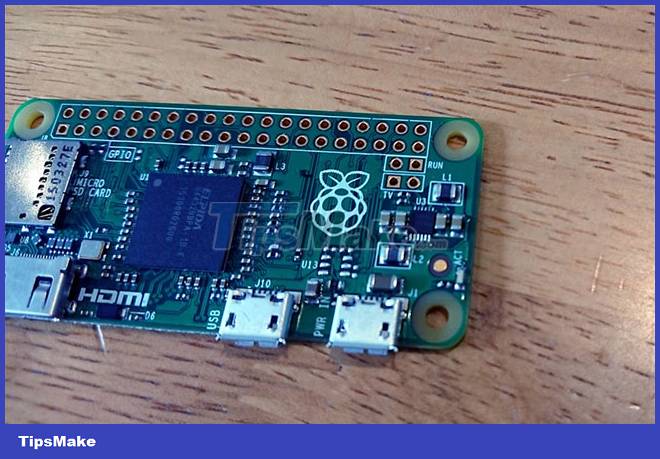7 causes of Raspberry Pi not booting and how to fix it
Here's what you need to check to troubleshoot Raspberry Pi that won't boot.
1. Raspberry Pi 4 not booting? Try these options

If you are using the latest version of Raspberry Pi, you should expect outstanding performance. But the fact that Raspberry Pi 4 won't boot makes you lose interest.
Three common problems that can lead to Raspberry Pi 4 not booting or not seeming to turn on
Power issue with Raspberry Pi 4
Raspberry Pi 4 uses a different power supply unit (PSU) than other models. Power via USB Type-C connector, preferably from an official 5.1V 3A PSU. As with older Raspberry Pi models, a mobile phone or tablet charger is not enough.
Raspberry Pi 4 not booting and showing red light?
Raspberry Pi 4 requires the installation of the latest Raspberry Pi operating system. In fact, regardless of your preferred Raspberry Pi operating system, you'll need a version released after June 2019.
Operating systems compatible with older Raspberry Pi models will not work reliably with the latest device. Using an older or unsupported operating system will result in a bright red LED when the Raspberry Pi 4 is powered on. It simply won't be possible to boot an operating system that is not designed to run on a computer.
Installing the latest operating system should solve many boot problems with the Raspberry Pi 4.
Raspberry Pi 4 no image
Having trouble viewing the output from your Raspberry Pi 4 on your monitor? The Pi 4 has two HDMI outputs. Specifically, these are the micro-HDMI ports, labeled HDMI0 and HDMI1.
Most Raspberry Pi 4 failure problems are caused by the HDMI cable being connected to the wrong port. Make sure to use the left connector, HDMI0.
It's not just the Raspberry Pi 4 that can have problems booting. The following steps will help you fix other Raspberry Pi models that won't boot.
2. Raspberry Pi not booting? Check red and green LEDs

When the Raspberry Pi starts up, one or more LEDs will activate. Red indicates power (PWR); the other is green, indicating activity (ACT). (There is also a trio of green Raspberry Pi LEDs that indicate Ethernet status, if connected).
So, what do these LEDs indicate? In the normal state, both the PWR and ACT LEDs are activated. ACT flashes during SD card operation. Therefore, if there is no this green light on your Raspberry Pi, then there is a problem with the SD card.
Meanwhile, the PWR flashes when the power drops below 4.65V. Thus, if the red light of the Raspberry Pi does not light, it means there is no power.
If only the red PWR LED is active and there is no blinking, the Pi is receiving power, but there are no readable boot instructions on the SD card (if one exists). On the Raspberry Pi 2, the ACT and PWR LEDs lit up mean the same thing.
When booting from the SD card, the green ACT light of the Raspberry Pi will blink abnormally. However, it can blink in other ways to indicate a problem:
- 3 flashes: Start.elf not found
- 4 flashes: Start.elf can't launch, so it might be broken. In addition, the card is not inserted properly or the card slot does not work can also be the cause.
- 7 flashes: No kernel.img . found
- 8 flashes: SDRAM not recognized. In this case, your SDRAM may be corrupted or unreadable bootcode.bin or start.elf.
If any of these occur, try the SD card with the freshly installed Raspberry Pi operating system. If that doesn't work, keep reading for another fix instead.
3. Raspberry Pi not turning on? Check PSU
As noted above, power issues can cause the Raspberry Pi to fail. It may shut down or hang while running, or simply won't start. To read SD cards correctly, a stable power supply (PSU) is required.
To make sure your PSU is okay, check that it meets the specifications of the Raspberry Pi model you are using. Similarly, confirm that the micro-USB from the PSU to the Pi is not problematic.
A lot of people use smartphone chargers to power their Raspberry Pi. This is usually not the best idea - a suitable, dedicated PSU is the preferred approach.
4. Is the Raspberry Pi's operating system installed?

Your Raspberry Pi will not boot without the operating system installed. Alternatively, you can use a boot script that allows you to install an operating system (such as NOOBS or BerryBoot).
Therefore, if no operating system is installed on the SD card, your Raspberry Pi will not boot.
This problem is very easy to fix. If your Raspberry Pi won't boot, check for any operating systems. Installing the Raspberry Pi operating system uses the Raspberry Pi Imager to select the operating system, download it, and install it.
5. Check the microSD card if Raspberry Pi won't boot
The Raspberry Pi relies on a good quality SD card to boot and run the operating system. If the SD card doesn't work, then your Raspberry Pi will be unstable or simply won't boot.
You can test the SD card by powering off the Pi and inserting it into your PC. Use a reliable flash drive format tool and try to reformat it (on Windows and Mac, use the SDFormatter tool from the SD Association). If the format fails, the card is damaged.
When setting up a new Raspberry Pi operating system, always format the SD card before burning the image. This means using a reliable card reader/writer, as well as the right media. Look for media with high write speed and superior error checking, to ensure Raspberry Pi is fast and efficient. Buy SD cards only from reputable vendors.
6. No video output on Raspberry Pi?
Your Raspberry Pi cannot display any video without a bootable SD card and a working HDMI cable.
The display device needs to be able to detect the signal from the Raspberry Pi. If the Pi doesn't seem to boot up because nothing appears on the screen, you'll need to force HDMI detection.
Because the Raspberry Pi has no BIOS, it relies instead on configuration files on the SD card. You can force HDMI detection by plugging your SD card into your desktop or laptop and browsing to the /boot/ partition. Open the config.txt file and add the following at the end:
hdmi_force_hotplug=1
Save and exit the file, safely remove the SD card, put it back in the Raspberry Pi, then power it back on.
Other video options are also possible. However, recent Pi models use TRRS, which means you need the right cable. This cable will be capable of translating RCA signals (red and white connectors) and mixed signals (yellow connectors).
You can find a suitable TRRS A/V cable on Amazon. This should work for you if HDMI isn't an option.
7. Raspberry Pi not booting? How to know if it's broken or faulty?

If you've gone to this step and the Raspberry Pi still won't boot, it's likely that the device is faulty.
Owning a Raspberry Pi B, B+, 2B, 3B, or 3B+, one way you can check if it's broken is to compare it to an identical model that you know is working.
Remove the SD card, Ethernet cable, power cord, and HDMI cable from the suspected device. Remove anything else connected and replace the working device with the same cable, peripherals, and SD card.
If the device just boots up, your Pi is faulty; if not, then your cable, power supply or SD card is causing the problem.
Meanwhile, for Raspberry Pi A, A+ and Zero devices, there are different ways to check for suspect devices. Remove all cables and SD card, connect the device via USB cable to your Windows PC. .
If active, the device will be detected and an alarm will sound. You should see the Raspberry Pi listed in Device Manager as "BCM2708 Boot". On Linux and Mac, a working Raspberry Pi A or Zero will be listed with the dmesg command.
The Raspberry Pi is covered by a 12 month warranty, but do not return it without first checking the terms and conditions.
Above are 7 things you need to check to fix Raspberry Pi booting problems. It can be summarized as follows:
Using Raspberry Pi 4? Check the power cable, operating system and HDMI cable
- Check LEDs
- Is the power supply suitable?
- Have you installed the operating system yet?
- Are microSD cards reliable?
- Is HDMI output disabled?
- Is your Raspberry Pi faulty?
After fixing the problem, now it's time to choose a Raspberry Pi project.
 Should choose Mini PC or Raspberry Pi?
Should choose Mini PC or Raspberry Pi? How to use Raspberry Pi for online meetings
How to use Raspberry Pi for online meetings How to install Windows 11 on Raspberry Pi 4
How to install Windows 11 on Raspberry Pi 4 What can be done with the 64-bit version of Raspberry Pi OS?
What can be done with the 64-bit version of Raspberry Pi OS? What's New in Raspberry Pi OS 11?
What's New in Raspberry Pi OS 11? What can you do with the Raspberry Pi 400?
What can you do with the Raspberry Pi 400?